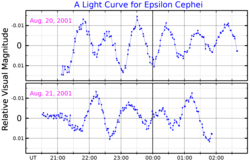Astronomy:Epsilon Cephei
| Observation data Equinox J2000.0]] (ICRS) | |
|---|---|
| Constellation | Cepheus |
| Right ascension | 22h 15m 02.19530s[2] |
| Declination | +57° 02′ 36.8771″[2] |
| Apparent magnitude (V) | 4.15 - 4.21[3] |
| Characteristics | |
| Spectral type | F0 V (Sr II)[4] or F0 IV[5] |
| U−B color index | +0.073[6] |
| B−V color index | +0.277[6] |
| Variable type | δ Sct[3] |
| Astrometry | |
| Radial velocity (Rv) | −4.7±0.8[7] km/s |
| Proper motion (μ) | RA: +481.53[2] mas/yr Dec.: +46.04[2] mas/yr |
| Parallax (π) | 38.17 ± 0.97[2] mas |
| Distance | 85 ± 2 ly (26.2 ± 0.7 pc) |
| Absolute magnitude (MV) | +2.13[8] |
| Details | |
| ε Cep Aa | |
| Mass | 1.64[9] M☉ |
| Radius | 1.86[10] R☉ |
| Luminosity | 11.65[8] L☉ |
| Surface gravity (log g) | 4.11±0.14[9] cgs |
| Temperature | 7,514±255[9] K |
| Metallicity [Fe/H] | +0.08[8] dex |
| Rotational velocity (v sin i) | 91[11] km/s |
| Age | 1.097[9] Gyr |
| ε Cep Ab | |
| Mass | 0.57[12] M☉ |
| Other designations | |
| Database references | |
| SIMBAD | data |
Epsilon Cephei, Latinized from ε Cephei, is a star in the northern constellation of Cepheus. Based upon an annual parallax shift of 38.17 mas as seen from the Earth,[2] it is located about 85 light years from the Sun. The star is visible to the naked eye with an apparent visual magnitude of 4.18.[6]
Properties
Physical Characteristics
This is a yellow-white hued, F-type star with a stellar classification of F0 V (Sr II)[4] or F0 IV.[5] Thus it may either be an F-type main sequence star showing an abundance excess of strontium, or it could be a more evolved subgiant star. It is a Delta Scuti variable star that cycles between magnitudes 4.15 and 4.21 every 59.388 minutes.[3] The star displays an infrared excess, indicating the presence of a debris disk with a temperature of 65 K orbiting at a radius of 62 AU. This dust has a combined mass equal to 6.6% of the Earth's mass.[10]
Binary
There is a faint companion star at an angular separation of 330±50 mas along a position angle of 90°±10°. This corresponds to a projected physical separation of 8.6±1.4 AU. The probability of a random star being situated this close to Epsilon Cephei is about one in a million, so it is most likely physically associated. If so, then the debris disk is probably circumbinary. The fact that this companion was not detected during the Hipparcos mission may indicate its orbit has a high eccentricity. The companion star has a K-band magnitude of 7.8 and is probably of class K8–M2.[5]
Naming
In Chinese, 螣蛇 (Téng Shé), meaning Flying Serpent, refers to an asterism consisting of ε Cephei, α Lacertae, 4 Lacertae, π2 Cygni, π1 Cygni, HD 206267, β Lacertae, σ Cassiopeiae, ρ Cassiopeiae, τ Cassiopeiae, AR Cassiopeiae, 9 Lacertae, 3 Andromedae, 7 Andromedae, 8 Andromedae, λ Andromedae, κ Andromedae, ι Andromedae, and ψ Andromedae. Consequently, the Chinese name for ε Cephei itself is 螣蛇九 (Téng Shé jiǔ, English: the Ninth Star of Flying Serpent)[14]
References
- ↑ Bruntt, H.; Suárez, J. C.; Bedding, T. R.; Buzasi, D. L.; Moya, A.; Amado, P. J.; Martín-Ruiz, S.; Garrido, R. et al. (January 2007), "Asteroseismology with the WIRE satellite I. Combining ground- and space-based photometry of the δ Scuti star ɛ Cephei", Astronomy and Astrophysics 461 (2): 619–630, doi:10.1051/0004-6361:20065766, Bibcode: 2007A&A...461..619B.
- ↑ 2.0 2.1 2.2 2.3 2.4 2.5 van Leeuwen, F. (2007), "Validation of the new Hipparcos reduction", Astronomy and Astrophysics 474 (2): 653–664, doi:10.1051/0004-6361:20078357, Bibcode: 2007A&A...474..653V.
- ↑ 3.0 3.1 3.2 "eps Cep", AAVSO Website (American Association of Variable Star Observers), https://www.aavso.org/vsx/index.php?view=detail.top&oid=9067, retrieved 2017-05-07.
- ↑ 4.0 4.1 Gray, R. O. et al. (2001), "The Physical Basis of Luminosity Classification in the Late A-, F-, and Early G-Type Stars. I. Precise Spectral Types for 372 Stars", The Astronomical Journal 121 (4): 2148–2158, doi:10.1086/319956, Bibcode: 2001AJ....121.2148G.
- ↑ 5.0 5.1 5.2 Mawet, D. et al. (September 2011), "A Dim Candidate Companion to epsilon Cephei", The Astrophysical Journal Letters 738 (1): 5, doi:10.1088/2041-8205/738/1/L12, L12, Bibcode: 2011ApJ...738L..12M.
- ↑ 6.0 6.1 6.2 Breger, M. (March 1968), "UBV and narrow-band UVBY photometry of bright stars", Astronomical Journal 73: 84–85, doi:10.1086/110602, Bibcode: 1968AJ.....73...84B.
- ↑ Gontcharov, G. A. (2006), "Pulkovo Compilation of Radial Velocities for 35 495 Hipparcos stars in a common system", Astronomy Letters 32 (11): 759–771, doi:10.1134/S1063773706110065, Bibcode: 2006AstL...32..759G
- ↑ 8.0 8.1 8.2 Anderson, E.; Francis, Ch. (2012), "XHIP: An extended hipparcos compilation", Astronomy Letters 38 (5): 331, doi:10.1134/S1063773712050015, Bibcode: 2012AstL...38..331A.
- ↑ 9.0 9.1 9.2 9.3 David, Trevor J.; Hillenbrand, Lynne A. (2015), "The Ages of Early-Type Stars: Strömgren Photometric Methods Calibrated, Validated, Tested, and Applied to Hosts and Prospective Hosts of Directly Imaged Exoplanets", The Astrophysical Journal 804 (2): 146, doi:10.1088/0004-637X/804/2/146, Bibcode: 2015ApJ...804..146D.
- ↑ 10.0 10.1 Rhee, Joseph H. et al. (May 2007), "Characterization of Dusty Debris Disks: The IRAS and Hipparcos Catalogs", The Astrophysical Journal 660 (2): 1556–1571, doi:10.1086/509912, Bibcode: 2007ApJ...660.1556R.
- ↑ Royer, F. et al. (February 2007), "Rotational velocities of A-type stars. III. Velocity distributions", Astronomy and Astrophysics 463 (2): 671–682, doi:10.1051/0004-6361:20065224, Bibcode: 2007A&A...463..671R.
- ↑ De Rosa, R. J.; Patience, J.; Wilson, P. A.; Schneider, A.; Wiktorowicz, S. J.; Vigan, A.; Marois, C.; Song, I. et al. (2013), "The VAST Survey - III. The multiplicity of A-type stars within 75 pc", Monthly Notices of the Royal Astronomical Society 437 (2): 1216, doi:10.1093/mnras/stt1932, Bibcode: 2014MNRAS.437.1216D.
- ↑ "eps Cep -- Variable Star of delta Sct type", SIMBAD Astronomical Database (Centre de Données astronomiques de Strasbourg), http://simbad.u-strasbg.fr/simbad/sim-id?Ident=eps+Cep, retrieved 2017-05-06.
- ↑ (in Chinese) AEEA (Activities of Exhibition and Education in Astronomy) 天文教育資訊網 2006 年 7 月 7 日
 |


